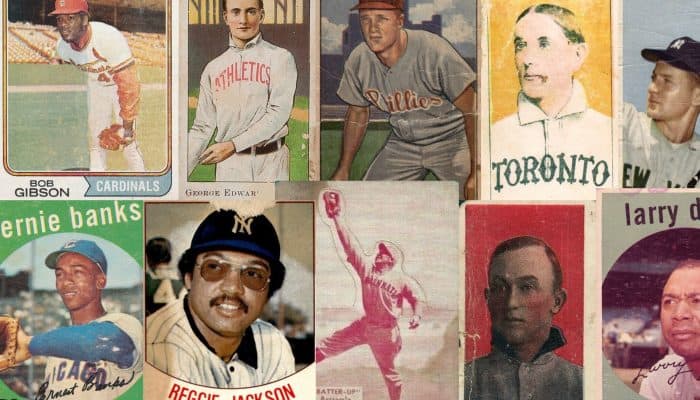
The Pittsburgh Pirates are a storied franchise in Major League Baseball. Founded in 1882, they boast a rich history filled with both championship glory and periods of struggle. Collecting the best Pittsburgh Pirates cards is a part of honoring that tradition.
Originally christened the Alleghenys, the team played in the American Association for its first five seasons before joining the National League (NL) in 1887. It was during this transition that the Pirates adopted their now-iconic pirate moniker, allegedly due to accusations of the team’s “piratical” tactics in acquiring players.
Victory has graced Pittsburgh on multiple occasions. The franchise has secured five World Series titles (1909, 1925, 1960, 1971, 1979) and nine National League pennants. These championship runs occurred throughout the team’s history, with periods of dominance separated by stretches of rebuilding.
During the 1960s and 1970s, the franchise became known for winning championships with homegrown, loyal talent.
These tides turned in the 1980s, when the city slid into decline by closing steel mills. The team began to take a more frugal approach and, thus, struggled to retain talent. Despite boasting young superstars like Barry Bonds and Bobby Bonilla and slugger Dave Parker, the Pirates fell short of reaching the World Series despite several strong regular seasons. Since then, the franchise has struggled to recapture its past glory. While they’ve made occasional playoff appearances, the Pirates haven’t reached the World Series since 1979.
Despite the recent lean years, the Pittsburgh Pirates remain a beloved team in the Steel City. With a rich history and a dedicated fanbase, their legacy is a testament to the enduring spirit of baseball. Here are the top 10 Pittsburgh Pirates players of all-time, plus the best Pittsburgh Pirates card for each player.
10. Bill Mazeroski
Player History
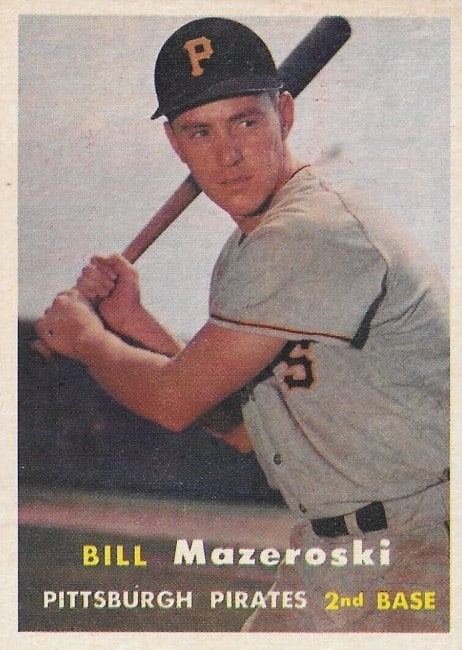
Bill Mazeroski, affectionately known as “Maz” and “The Glove,” spent his entire 17-year Major League Baseball career with the Pittsburgh Pirates. Primarily known for his exceptional defensive skills at second base, his legacy is forever intertwined with the dramatic walk-off home run he hit in Game 7 of the 1960 World Series, the first in baseball history to end the Series.
Mazeroski had numerous, celebrated accolades in his career with the Pirates. He earned seven All-Star selections (1960-1966, 1969) and eight Gold Gloves (1964-1971), a testament to his defensive prowess. Mazeroski was one of the best defenders of the 1960s, with a bWAR over 1.5 for eight seasons. He was also durable: As a starter from 1957-1968, Mazeroski averaged 150 games per season.
Mazeroski wasn’t just a valuable member of the Pirates; he became a symbol of the franchise’s resilience. The final at-bat of the 1960 World Series, where the underdog Pirates faced the heavily favored New York Yankees, shocked the baseball world. Down to their last strike in the bottom of the ninth inning of Game 7, Mazeroski’s walk-off home run cemented the Pirates’ victory and etched his name into baseball lore. Said Bill Mazeroski: “The home run took a while to sink in because all I could think of was, ‘We beat the Yankees! We beat the Yankees.'”
This iconic moment transcended the game, becoming a cultural touchstone and a source of immense pride for Pittsburgh. Following his retirement in 1972, Mazeroski remained involved with baseball, serving as a coach and broadcaster for the Pirates.
Bill Mazeroski was inducted into the National Baseball Hall of Fame in 2001.
Best Pittsburgh Pirates baseball card: 1957 Topps Bill Mazeroski #24 (RC)
The Pirates signed Bill Mazeroski as a 17-year old, and he debuted with the team in his age 19 season. The 1957 Topps rookie is his most collectible card. The set features beautiful color photography with a defined white border. Mazeroski’s rookie costs approximately $300-$500 for a PSA 7 or PSA 8. Higher grades are difficult, but not impossible, to find; they can cost thousands.
9. Babe Adams
Player History
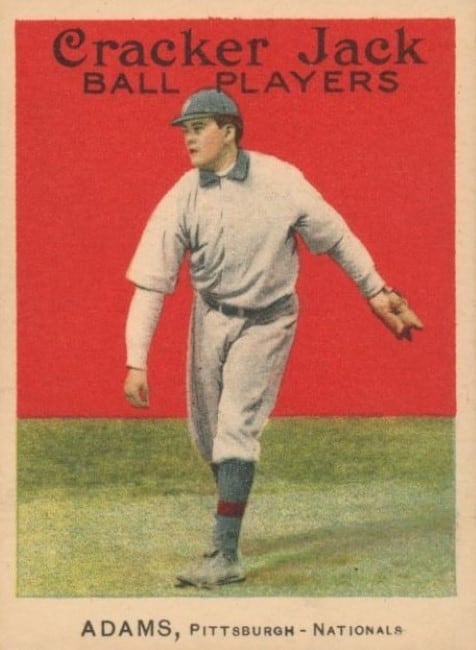
Charles Benjamin “Babe” Adams, a right-handed pitcher, spent nearly his entire 21-year Major League Baseball career (1906-1926) with the Pittsburgh Pirates (1909-1926). Noted for his remarkable control and exceptional longevity, Adams became a cornerstone of the Pirates’ pitching staff.
Adams’ achievements with the Pirates are numerous. He holds the franchise record for career victories by a right-hander (194) and shutouts (47). He led the National League in Earned Run Average twice (1910, 1914) and in Walks per Nine Innings once (1920). Moreover, his career average of 1.29 walks per nine innings pitched remains the second-lowest of the 20th century, showcasing his exceptional control. Additionally, he holds the modern record (until 2005) for the fewest walks per nine in a season (1.00 in 1920).
Adams served as a vital cog in the Pirates’ pitching rotation, consistently delivering quality starts and contributing to their championship aspirations. He played a crucial role in the team’s 1909 World Series victory, pitching three complete-game victories as a rookie and setting a record for rookies that still stands today. His presence brought stability and consistency to the pitching staff, earning him the respect of his teammates and coaches.
Despite his accomplishments, Adams never received the individual accolades some of his contemporaries did. He was never selected to an All-Star game, which wasn’t established until 1933. Nonetheless, his impact on the Pirates and his lasting contributions to the franchise are undeniable. His longevity, remarkable control, and consistent performance solidified his place as one of the best pitchers in Pirates history.
Babe Adams has not been elected to the Hall of Fame.
Best Pittsburgh Pirates baseball card: 1915 Cracker Jack Babe Adams #63
Not a lot of cards were issued during Babe Adams’ playing days. The 1915 Cracker Jack is the most notable – a set loaded with the likes of Shoeless Joe Jackson, Ty Cobb and myriad other superstars. You can find this card in decent shape, despite its age, and a PSA 8 runs around $1,000-$1,500.
8. Max Carey
Player History
Max Carey, born Maximilian George Carnarius, carved a 17-year Major League Baseball career, with 16 of those spent with the Pittsburgh Pirates (1910-1926). He is primarily remembered for his exceptional speed and base running skills, known for his daring and innovative sliding techniques.
“Base stealing is a battle of wits between the runner and the pitcher.”
– Max Carey
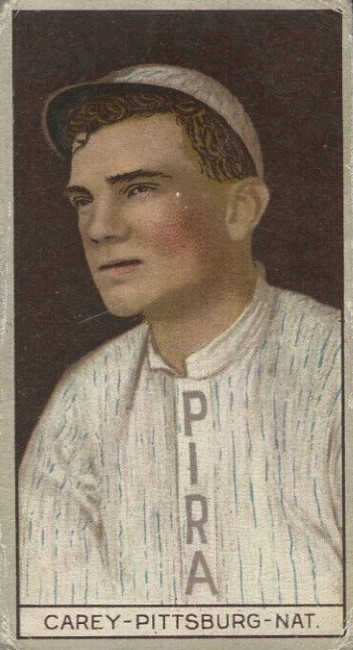
Carey joined the Pirates as a 20 year old rookie shortstop. The problem? The Pirates had a shortstop: Honus Wagner. Instead, Carey moved to the outfield and became a defensive standout at his brand new position, playing primarily center field.
Carey’s presence on the Pirates’ lineup added a dynamic element and forced opposing teams to play him with caution. His offensive production, coupled with his base-stealing prowess, kept pressure on the defense and created scoring opportunities. He enjoyed a positive relationship with his teammates and coaches, known for his humor and dedication to the team.
Carey had numerous achievements during his career with the Pirates. He achieved a .300 batting average six times, and he won a World Series title in 1925 while leading the team with a .458 average and three stolen bases.
Max Carey also holds the franchise record for stolen bases, swiping 571 bases. He led the National League in stolen bases a staggering ten times, including six consecutive seasons from 1915 to 1920. He is ninth all-time in stolen bases, with more stolen bases than legendary speedsters Joe Morgan and Kenny Lofton. Said Carey: “Stealing bases is the art of picking up little things – things like a spitball pitcher who never threw to first if he was going to throw a spitter to the plate.”
Carey was also an innovator whose ideas are still influencing baseball players over a century later. For example, Carey’s mother – concerned for her son’s well being – sewed a sliding pad into his pants. Carey later patented it, and many modern players wear sliding shorts or padding of some kind. He was also one of the first players to use flip-down sunglasses in the field.
Max Carey was inducted into the National Baseball Hall of Fame in 1961.
Best Pittsburgh Pirates baseball card: 1912 T207 Max Carey
In a sport that would soon be dominated by sluggers, Max Carey often stayed off the radar. He’s in the legendary 1915 Cracker Jack set, but a better choice is his much rarer 1912 T207. Cards in the middle grades cost around $300-$500, and no example beyond a PSA 7 are known to exist.
7. Barry Bonds
Player History
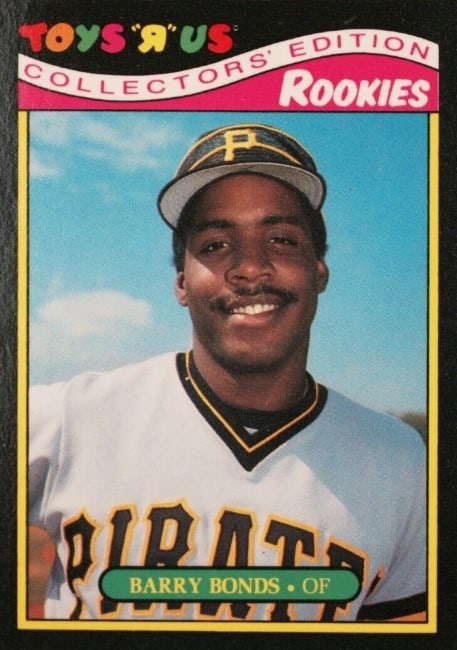
Barry Bonds, renowned for his later exploits with the San Francisco Giants, played his first seven seasons (1986-1992) with the Pittsburgh Pirates. During this time, he established himself as a gifted baseball player, evolving from a raw talent into a feared power hitter and all-around offensive threat.
In Pittsburgh, Bonds was famous for speed moreso than power. He stole 5 bases in 1990, with 33 home runs. However, over time he transitioned from a slap-hitting approach to a more powerful swing, a change that unlocked his full potential as a hitter.
Because many of Barry Bonds accolades came after he joined the Giants, it’s easy to forget that he was a remarkable hitter for seven seasons in Pittsburgh too. From 1990 to 1992, Bonds won MVP twice and finished second once. He also won three Gold Gloves, three Silver Slugger awards and went to the All-Star Game twice.
Barry Bonds had nearly 1,000 hits in his time with the Pirates and an OBP of .380. He also led the league in slugging twice as he transitioned into a power hitter. In the same period of time, Bonds also guided the Pirates to three consecutive NLCS series. These stats and achievements paved the way for his historic free agent signing with San Francisco in 1993.
Of course, we know what happened next – four straight MVPs with the Giants and a record-breaking 762 all-time homeruns. However, Bonds became a disgraced figure when he was indicted for his role in the BALCO scandal. The courts alleged that a network of medical professionals and athletes were using, and covering up, performance-enhancing drugs. This scandal plagued Major League Baseball in the early 2000s. There is inconclusive evidence that Bonds ever knowingly used steroids but, ultimately, his name became synonymous with the scandal.
Barry Bonds has not been elected to the Baseball Hall of Fame.
Best Pittsburgh Pirates baseball card: 1987 Toys “R” Us Rookies Barry Bonds #4 (RC)
Barry Bonds has a number of Pirates rookie cards on the market from the 1986 and 1987 sets, and they’re all valuable in their own right. But a few things make this Toys “R” Us card stand out. First, nothing says “80s childhood dreams” like Toys “R” Us. Many Gen Xers have fond memories of walking those aisles. Also, this is only one of only two Bonds rookies where he’s smiling, which adds to the feeling of childhood joy. In ungraded condition, the card costs around $5-10. High grades are $50-$100.
6. Pie Traynor
Player History
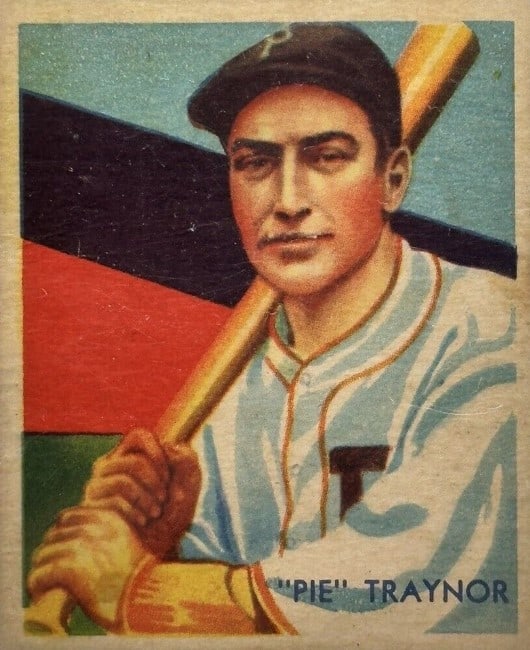
Harold Joseph “Pie” Traynor, born in 1898, spent his entire 18-year Major League Baseball career with the Pittsburgh Pirates, solidifying his place as a legend of the franchise. Primarily known for his exceptional defense at third base and consistent hitting, Traynor captained the team to their first World Series victory in 16 years and became a cornerstone of their success in the 1920s and 1930s.
Offensively, Traynor batted over .300 ten times, with seven seasons where he drove in over 100 runs. Notably, he led the league in triples in 1923, showcasing his base-running ability. Traynor also finished in the Top 20 of MVP voting an amazing nine times. This was a testament to his consistency, although he never won it. He finished his career with 2,416 hits and a .320 batting average and a .362 OBP.
Traynor won the World Series in 1925. He hit .346 in the series with 4 RBI and the second-highest OPS on the team. He also managed the Pirates for six seasons, including several as a player-manager. Traynor finished his managerial career with a .530 winning percentage. In later years, he served as a scout and radio personality in Pittsburgh.
Traynor was widely-regarded as the best pre-World War II third baseman, whose accomplishments have been eclipsed only by the evolution of the game into one dominated by power hitters.
Pie Traynor was inducted into the National Baseball Hall of Fame in 1948.
Best Pittsburgh Pirates baseball card: 1934-1936 Diamond Stars Pie Traynor #27
Pie Traynor appears in famous sets like 1933 Goudey, but the 1934 Diamond Stars Pirates card is more fun to chase, has better aesthetics and a better chase for collectors. The card has some of the most vibrant colors of the era, and a nice composition overall. The card costs around $200 in mid-range conditions.
5. Paul Waner
Player History
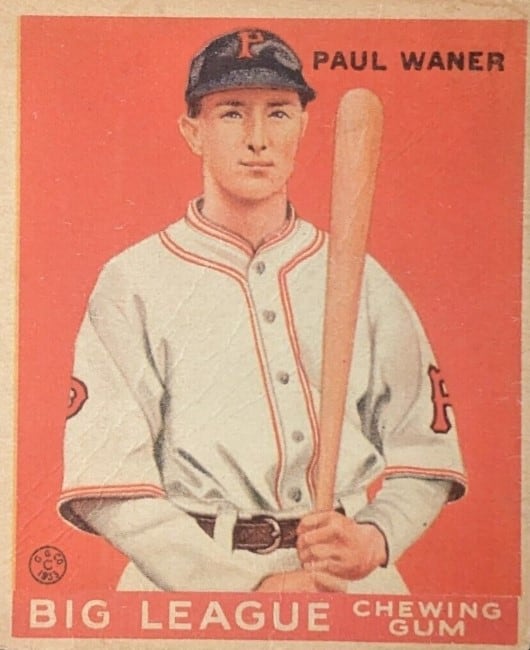
Paul Waner, nicknamed “Big Poison,” patrolled the right field for the Pittsburgh Pirates for 15 seasons, from 1926 to 1940. Renowned for his consistent hitting and defensive prowess, Waner established himself as a cornerstone of the Pirates’ lineup and a fan favorite.
Waner’s enjoyed numerous accolades during his tenure with Pittsburgh. He led the National League in batting average three times (1927, 1934, and 1936), his 1927 title propelling him to the National League’s Most Valuable Player award. Notably, his 1927 season saw him lead the league in hits (237), runs batted in (131), and stolen bases (37), solidifying his all-around offensive talent.
For his career, Waner held many Pirates records. He’s second all-time in batting average (.340) and runs scored, and third in hits for the franchise. He’s also third all-time in WAR for Pittsburgh. He had 3,152 hits in his career (19th all-time in MLB), 2,868 of which came for the Pirates. He batted .300 or better fourteen times in his career.
Paul Waner played alongside his brother, Lloyd, for the majority of his career. Paul Waner allegedly received his nickname, “Big Poison,” by accident. Waner’s nickname was “Big Person” – contrasting with his brother, “Little Person” – but fans with New York accents sounded like they were saying “Poison” instead. The names stuck.
Paul Waner was inducted into the National Baseball Hall of Fame in 1952.
Best Pittsburgh Pirates baseball card: 1933 Goudey Paul Waner #25
Paul Waner is in the 1933 Goudey set – his first full-color card. Prices for this card vary wildly, with anything near-mint priced in the thousands. In mid-grades, the card is a more affordable $200-$400. For a little humor, check out the 1936 National Chicle Fine Pens, featuring “Big Jim” Weaver holding Paul and Lloyd Waner on his shoulders. This Pirates card costs under $100 in mid-grade conditions.
4. Arky Vaughan
Player History
Joseph Floyd “Arky” Vaughan played for the Pittsburgh Pirates for ten seasons, from 1932 to 1941. He established himself as a premier shortstop in the National League, earning a reputation for his defensive prowess and offensive contributions.
“I am convinced that, pound for pound, Arky Vaughan is the least-known great Major League Baseball player ever.”
-Joe Posnanski
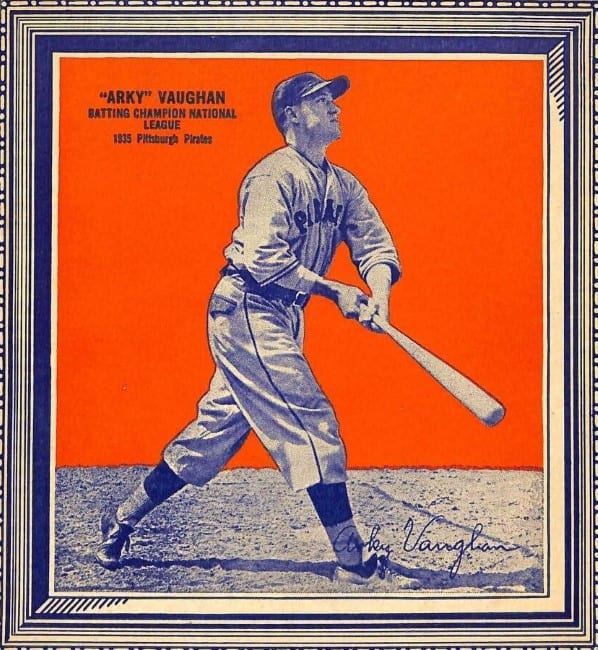
Vaughan had many exceptional achievements during his years with the Pirates. He led the National League in runs scored twice (1936 and 1940) and triples three times (1935 and 1938). He batted over .300 in all ten seasons with the Pirates, reaching a league-leading .385 in 1935, a record for 20th-century National League shortstops and a franchise record for the Pirates. Vaughan was also named to the National League All-Star team eight times, and he received MVP votes in seven of his ten seasons with Pittsburgh.
Vaughan was overlooked in many ways because he didn’t play for great teams, and because he was so consistently great that it was easy for fans to become complacent about his abilities. In fact, Vaughan never played a season – for any team – in which he didn’t either receive MVP votes or appear in an All-Star Game. Bill James, in his The New Bill James Historical Baseball Abstract, ranked Vaughan as the second-greatest shortstop ever.
Vaughan retired, relatively young, at the age of 31 to spend more time with his family. Tragically, several years later Vaughan and a friend were fishing when their boat capsized in a storm. Vaughan tried to rescue his friend, but they both died. Vaughan was 40 years old.
Sportswriter Milt Richman commented: “As exceptional a ballplayer as he was, Vaughan was every bit as noble a human being. This isn’t something I found out about him in a book. It’s what I discovered for myself from knowing him.”
Arky Vaughan was elected to the National Baseball Hall of Fame in 1985.
Best Pittsburgh Pirates baseball card: 1936 Wheaties Series 3 Arky Vaughan
Wheaties issued some memorable cards in the 30s. These were printed in the brand’s colors and had to be cut off the cereal box. Arky Vaughan’s 1936 Wheaties card celebrates his batting title against a red background, with a facsimile signature in the corner. The cards are all hand-cut, so try to find one that includes the postage stamp-like border. The cards, while rare, maintain their condition because they’re printed on thick cardboard. Vaughan’s Wheaties card is about $50 in ungraded, mid-range condition.
3. Willie Stargell
Player History
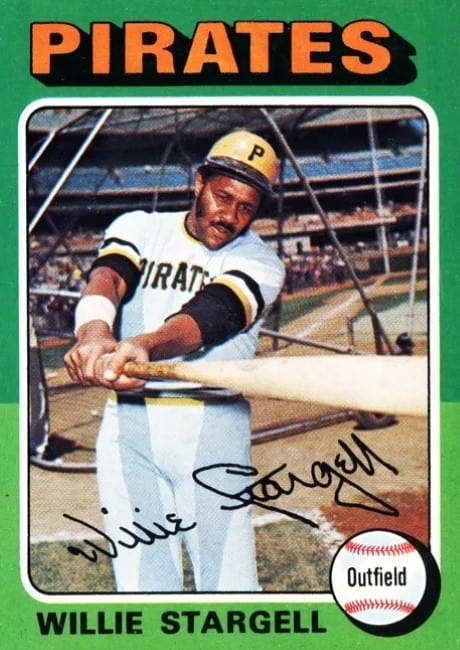
Willie Stargell, affectionately known as “Pops” later in his career, spent his entire 21-year Major League Baseball career with the Pittsburgh Pirates (1962-1982). He carved out a legacy as one of the most feared power hitters of his generation. Stargell’s imposing presence at the plate and his ability to launch tape-measure home runs into the vast expanses of Forbes Field and Three Rivers Stadium captured the imagination of fans.
Stargell’s trophy cabinet reflects his impact on the game. A seven-time All-Star, he led the National League in home runs twice, swatting a career-high 48 in 1971 and following it up with 44 in 1973. That 1971 season was particularly noteworthy. Stargell’s bat helped propel the Pirates to their first World Series title in decades, and his strong performance earned him a second-place finish in the National League Most Valuable Player voting. He would add another significant achievement in 1979, capturing both the National League MVP Award and World Series MVP Award as the Pirates secured their second championship of the decade.
Stargell was 39 years old when he won MVP – the oldest player to do so at the time (now second to Barry Bonds). He finished in the Top 3 of MVP voting an additional three times in his career. Heretired with a lifetime batting average of .282, 475 home runs and 2,232 hits. He also holds the Pirates franchise record for home runs (475) and RBIs (1,409).
Willie Stargell was inducted into the National Baseball Hall of Fame in 1988.
Best Pittsburgh Pirates baseball card: 1975 Topps Willie Stargell #100
Willie Stargell had a unique batting grip, where he would place his bottom hand around the knob of the bat. This gave him extra reach and control. Stargell’s 1975 Topps card shows his impressive swing, with a look at his hand positioning too. In graded condition, PSA 8s or lower are well under $100, with premium prices only for the high grades.
2. Roberto Clemente
Player History
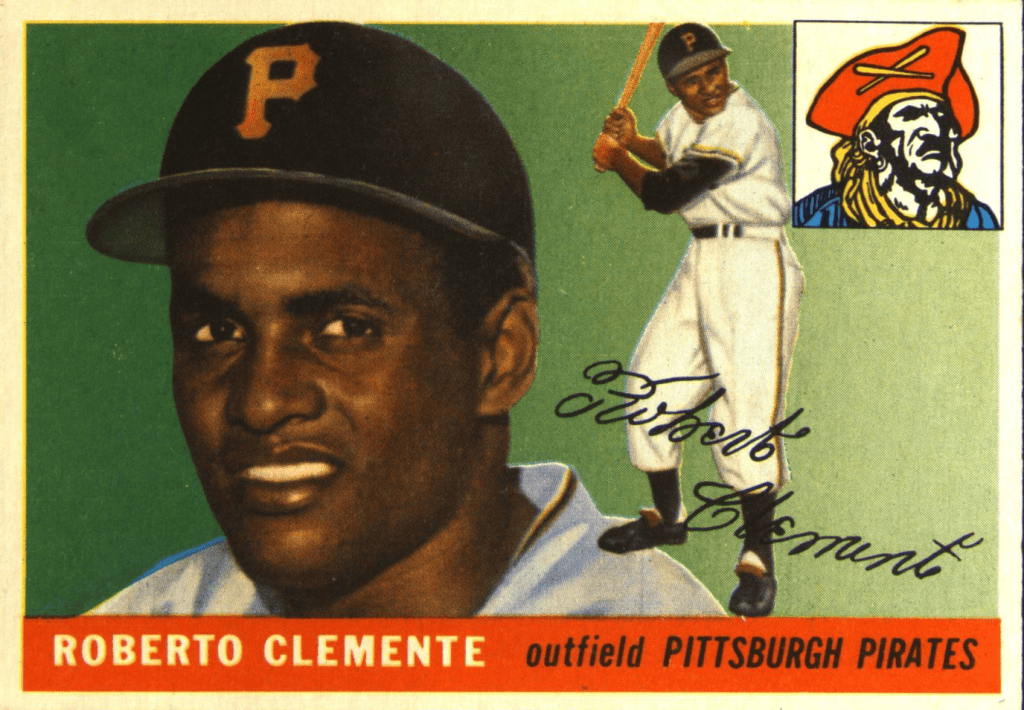
A true legend, Clemente was a well-rounded player with exceptional hitting (.315 career average), power, and defense (12 Gold Gloves). He won an MVP award, a World Series title in 1971, and remains a revered figure in the community.
Roberto Clemente, a name synonymous with baseball excellence and humanitarianism, spent his entire 18-year Major League Baseball career with the Pittsburgh Pirates (1955-1972). He established himself as a five-tool player; however, it was his potent bat that truly captured the fans’ attention, earning him the nickname “The Great One.”
Clemente was a 12-time Gold Glove Award winner in right field – the most ever at the position – and he displayed exceptional defensive prowess throughout his career. Offensively, Clemente led the National League in batting average four times (1961, 1965, 1966, 1970) and became just the 11th player in history to reach the coveted 3,000 hit milestone in 1972.
Clemente’s crowning achievement in baseball was his National League MVP Award in 1966. Clemente was also a key contributor to the Pirates’ World Series victories in 1960 and 1971, earning World Series MVP honors in the latter.
For his career, Roberto Clemente had 3,000 hits, 240 homeruns and a .317 batting average. He is tied with Honus Wagner for the lead in games played for the Pirates (2,433). He also leads the team in all-time hits.
Clemente was an amazing player, but his impact transcended the game. A vocal advocate for Latino players in baseball, he paved the way for future generations. His tragic death in a plane crash while delivering earthquake relief supplies to Nicaragua in 1972 sent shockwaves through the baseball world. However, his legacy continues to inspire. Major League Baseball instituted a special award in his name to recognize outstanding humanitarian efforts.
Said Clemente: “Any time you have an opportunity to make a difference in this world and you don’t, then you are wasting your time on Earth.”
The National Baseball Hall of Fame waived its usual five-year waiting period and elected Roberto Clemente to the Hall of Fame in 1973.
Best Pittsburgh Pirates baseball card: 1955 Topps Roberto Clemente #164 (RC)
Rarely does a legendary set land at the same time as a legendary rookie, but the 1955 Topps Roberto Clemente card is one of those times. The cards are in horizontal format, with dual color images, and a facsimile signature.
In 2021, a 1955 Topps Roberto Clemente PSA 9 card sold for over $1.1 million at auction, making it the eighth most expensive card of all time. Budget-minded collectors will need to chase lower grades. The average graded price of a Clemente rookie is $3,000-$7,000.
1. Honus Wagner
Player History
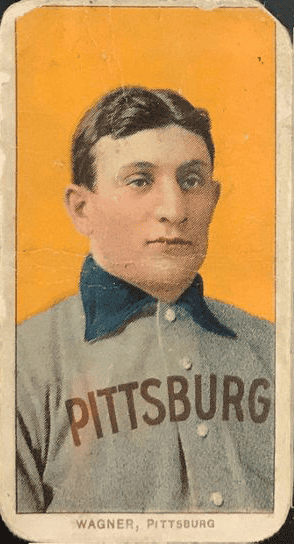
When you talk about the greatest baseball players of all time, Honus Wagner is in that conversation. Wagner spent 18 seasons with the Pittsburgh Pirates and he is the team’s all-time leader in WAR (120.3). Renowned for his consistent hitting and defensive prowess, he is a legend within the franchise and the sport itself.
Renowned for his consistent hitting, “The Flying Dutchman” boasts the highest career WAR (120.3) amongst Pirates players, along with 8 batting titles and multiple stolen base titles. While he never won a World Series with the Pirates, his impact on the franchise is undeniable.
Wagner’s remarkable statistics show the player he was. He won eight batting titles, tied for second all-time (Ty Cobb is first with eleven). He led the league in slugging percentage six times and stolen bases five times, showcasing his well-rounded offensive skill set.
Wagner had a smooth swing, exceptional hand-eye coordination, and remarkable speed on the basepaths. Off the field, he had a quiet demeanor and showed dedication to the game, earning the nickname “The Flying Dutchman” due to his German heritage and swiftness on the field.
Honus Wagner was elected to the National Baseball Hall of Fame as part of the inaugural class in 1936.
Best Pittsburgh Pirates baseball card: 1909-1911 T206 Honus Wagner
Was there any doubt? The T206 Honus Wagner card is the most famous baseball card in the world. Few copies of this card exist, and condition is always an issue when you do find them. Not only is natural condition a concern, but it’s important to look out for doctored versions too. So get out your checkbooks: An authentic T206 Honus Wagner sold to a private buyer in 2022 for $7.25 million.
If you can’t afford the multi-million dollar price tag of an authentic T206 Honus Wagner, consider this runner-up: 1914-1915 E145 Cracker Jack Honus Wagner #68. These cards still aren’t cheap, but they’re easier to find than their contemporaries because they came from a major set. It’s still not cheap – expect to pay $20,000 on the low end – but for a card of Honus Wagner from his playing days, this is the value end of the spectrum.



